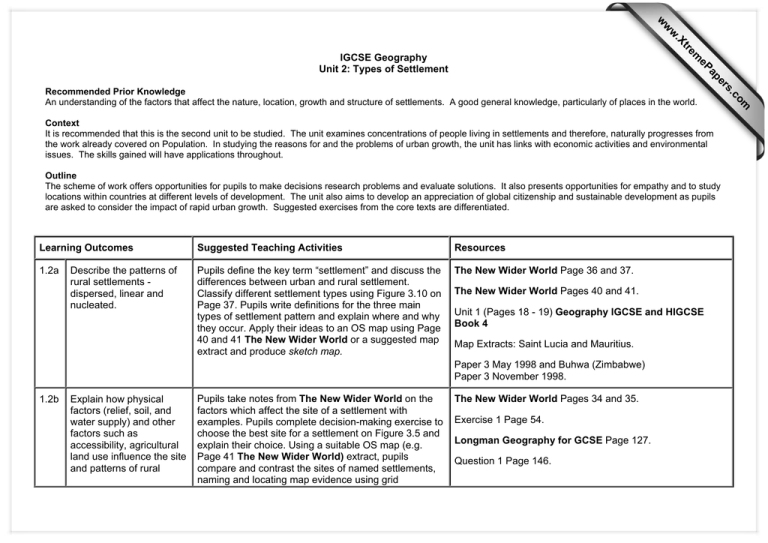IGCSE Geography: Types of Settlement Scheme of Work
advertisement

e tr .X w w w Context It is recommended that this is the second unit to be studied. The unit examines concentrations of people living in settlements and therefore, naturally progresses from the work already covered on Population. In studying the reasons for and the problems of urban growth, the unit has links with economic activities and environmental issues. The skills gained will have applications throughout. Outline The scheme of work offers opportunities for pupils to make decisions research problems and evaluate solutions. It also presents opportunities for empathy and to study locations within countries at different levels of development. The unit also aims to develop an appreciation of global citizenship and sustainable development as pupils are asked to consider the impact of rapid urban growth. Suggested exercises from the core texts are differentiated. Learning Outcomes Suggested Teaching Activities Resources 1.2a Pupils define the key term “settlement” and discuss the differences between urban and rural settlement. Classify different settlement types using Figure 3.10 on Page 37. Pupils write definitions for the three main types of settlement pattern and explain where and why they occur. Apply their ideas to an OS map using Page 40 and 41 The New Wider World or a suggested map extract and produce sketch map. The New Wider World Page 36 and 37. Describe the patterns of rural settlements dispersed, linear and nucleated. The New Wider World Pages 40 and 41. Unit 1 (Pages 18 - 19) Geography IGCSE and HIGCSE Book 4 Map Extracts: Saint Lucia and Mauritius. Paper 3 May 1998 and Buhwa (Zimbabwe) Paper 3 November 1998. 1.2b Explain how physical factors (relief, soil, and water supply) and other factors such as accessibility, agricultural land use influence the site and patterns of rural Pupils take notes from The New Wider World on the factors which affect the site of a settlement with examples. Pupils complete decision-making exercise to choose the best site for a settlement on Figure 3.5 and explain their choice. Using a suitable OS map (e.g. Page 41 The New Wider World) extract, pupils compare and contrast the sites of named settlements, naming and locating map evidence using grid The New Wider World Pages 34 and 35. Exercise 1 Page 54. Longman Geography for GCSE Page 127. Question 1 Page 146. om .c Recommended Prior Knowledge An understanding of the factors that affect the nature, location, growth and structure of settlements. A good general knowledge, particularly of places in the world. s er ap eP m IGCSE Geography Unit 2: Types of Settlement Learning Outcomes settlements. Suggested Teaching Activities Resources references. Skills Based Exercise: Pupils describe the density of transport routes and their relation to human and physical features using map extract from Paper 3 May 1998. Unit 1 (Page 19) Geography IGCSE and HIGCSE Book 4 http://www.s-cool.co.uk/subject_index.asp (GCSE, then Geography, then Settlements - Site and Situation) Paper 3 May 1998 Question 1 (f) Paper 3 October 2000 1.2c 1.2d 1.2e Describe and explain the factors which may influence the size, growth and functions of rural and urban settlements. Pupils define the key term “function” and understand the range of functions that a settlement can have. Pupils back up their ideas with examples and explain how the function(s) of a settlement is/are linked to its growth. Describe and suggest reasons for the hierarchy of settlements and services. Pupils define key term "hierarchy" and produce a diagram to show a settlement hierarchy. Pupils understand the criteria that can be used to place settlements into a hierarchy – population size, range and number of services and sphere of influence. Pupils show the relationship between population size and range of services by completing Exercises 3, 4 and 5 The New Wider World. Describe and explain the internal structure (morphology) of towns and cities to include the CBD, residential areas, industrial areas, open space and transport routes. Pupils define key terms – “land use” and “morphology”. Pupils draw annotated diagrams to show the models of urban land use in MEDC’s to include the Burgess Model and the Hoyt Sector Model and describe the factors that have influenced patterns of urban land use e.g. land values, age, accessibility etc. Pupils understand when and why urbanisation took place in MEDC’s. Pupils use photographs, maps and graphs to describe the characteristics of each land use zone. The New Wider World Page 37. http://www.s-cool.co.uk/subject_index.asp (Select GCSE, then Geography, then Settlements Functions) The New Wider World Page 38 and 39 Exercises 3, 4 and 5 Page 126 and 127. Longman Geography for GCSE Page 126. Question 1 Page 146 http://www.s-cool.co.uk/subject_index.asp (Select GCSE, then Geography, then Settlements Hierarchies) The New Wider World Pages 42 to 49. Exercises 6 to 9 Pages 56 and 57. Longman Geography for GCSE Pages 128 to 133 and 142 to 143. Question 2, 3 and 4 Pages 146 to 147 Learning Outcomes 1.2e Describe and explain differences in the patterns of urban structures in cities of developing and developed countries of the world. Suggested Teaching Activities Resources Opportunity for centres to use slides/maps of local urban area and conduct local fieldwork. Pupils should also consider the socio-economic characteristics of each zone and give reasons for this e.g. unemployment, immigrant population, age etc. Pupils plan land use and growth in their own city by using the simulation "SimCity." http://www.geography.learnontheinternet.co.uk/topics/landus e.html Pupils draw a fully labelled diagram to show a model of land use for a developing world city. Pupils construct a table to show the main similarities and differences between developing and developed world city structures. The New Wider World Page 81. Exercise 3 Page 90. http://www.s-cool.co.uk/subject_index.asp (Select GCSE, then Geography, then Settlement - Urban Models) http://www.schoolsnet.com (Select Revision - Geography - Urban Growth) 1.2f Describe and suggest reasons for changes in urban land use especially through time with the growth or urban settlements. Pupils research the causes and effects of changes that have occurred in cities in the developed world to include: changes to the CBD, the decline and renewal/redevelopment of the inner city, suburbanisation and reurbanisation. This section should include the causes and effects of each change on people, the environment and the economy. It may include a consideration of solutions e.g. urban renewal/redevelopment in the inner city. Pupils present their ideas as a report or newspaper article. Complete suggested activities to consolidate their ideas. The New Wider World Page 58 to 65. Exercise 1, 2 and 3 Pages 75 and 76. Longman Geography for GCSE Page 130 to 133. Question 3 Page 146. Question 2 Paper 2 June 2000. http://www.s-cool.co.uk/subject_index.asp (Select GCSE, then Geography, then Settlement Urbanisation) Learning Outcomes Suggested Teaching Activities 1.2g Pupils define the key term urbanisation and draw graphs to show growth in urban populations in different parts of the world. Pupils describe the changing distribution of the world’s largest cities. Pupils explain why cities in LEDCs are growing so quickly (link back to population) and why growth in MEDCs is slowing down. Describe the problems associated with growth of urban areas such as congestion in the CBD, housing shortages, and traffic congestion. Resources The New Wider World Pages 78 and 79. Exercise 1 Page 90. Question 2 Paper 2 November 1998 http://www.geography.learnontheinternet.co.uk/topics/urban.h tml http://www0.un.org/cyberschoolbus/habitat/index.asp http://geography.about.com (Select largest cities) www.georesources.co.uk (Select GCSE, Settlement - articles relating to urban growth) 1.2g Describe the problems associated with the growth of urban areas such as congestion in the CBD, housing shortages, and traffic congestion. Teaching through the case study of Rio de Janeiro, pupils take notes on the problems faced by people living in developing world cities and explain some of the solutions that have been taken. To include the reasons for the growth and location of shantytowns (favelas), the conditions for people living in shantytowns and attempts made to solve the problems. Pupils use Internet and textbook references to write a presentation on the problems of living in developed world cities with an appropriate example. The presentation should also include a range of strategies to overcome the problems e.g. transport policy. The New Wider World Pages 86 to 87. Exercise 5 Page 91. The New Wider World Pages 80 to 85. Longman Geography for GCSE Page 134 to 135 and 140 to 141122; 125. http://www.bbc.co.uk/education/gcsebitesize/index.shtml. (Go into Cities Human Geography, then LEDC Cities - case study on Rio de Janeiro) http://www.georesources.co.uk/ (Select Settlement for a number of related articles, including Rio de Janeiro coverage) Learning Outcomes Suggested Teaching Activities Resources http://www.geography.learnontheinternet.co.uk/topics/urbanis ation.html (Select Problems in MEDC’s and LEDC’s) http://www.s-cool.co.uk/ (Select GCSE, then Geography, then Settlement Urbanisation) Question 2 Paper 1 May 1999 Question 2 Paper 1 May 1998 Question 2 Paper 1/2 October 2000 1.2h 1.2h Describe the effects of urbanisation on the environment and the results of urban sprawl on the surrounding area. Describe the effects of urbanisation on the environment and the results of urban sprawl on the surrounding area. Pupils define the key terms - urban sprawl and ruralurban fringe. Use a suitable map extract to brainstorm the land uses associated with the rural-urban fringe and what they have in common. Pupils take notes on the pressures on the rural urban fringe and how these can be controlled. Class discussion of the effects of urbanisation upon the environment to include air, water, noise and visual pollution. Pupils research examples using Internet references and present their ideas as a report. Pupils brainstorm the location factors involved in the siting of a large out of town shopping centre and undertake a decision making exercise to choose the best site. Pupils conduct role-play to understand the social, environmental and economic costs and benefits of out of town shopping and back up their ideas with an appropriate case study. Pupils discuss the costs and benefits of other large-scale developments which occur at the edge of cities e.g. motorways, airports, housing estates etc. The New Wider World Pages 62 to 65. Longman Geography for GCSE Page 132. http://www.un.org/Pubs/CyberSchoolBus/special/habitat/inde x.html (Select Table of Contents for a number of related articles for this unit) http://www.s-cool.co.uk/ (Select GCSE, then Geography, then Settlement - Urban Fringe) The New Wider World Page 63. Longman Geography for GCSE Page 133. Question 4 Page 147 Paper 1 May 1999 http://www.schoolsnet.com/ (Select Revision - Geography - Urban Dynamism and Challenge)





